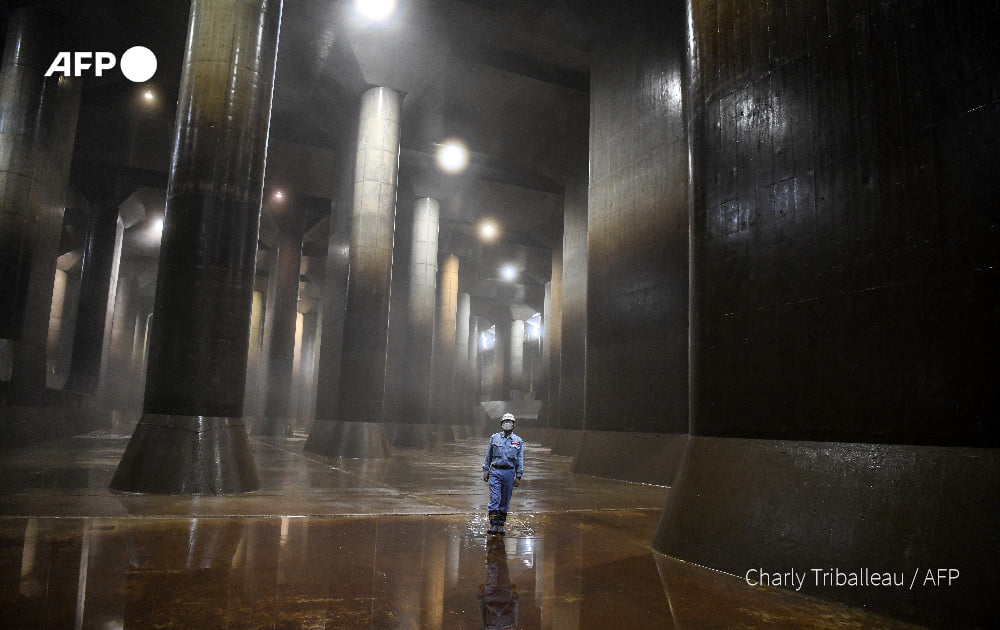IN PHOTOS: Japan’s ‘Parthenon’ protecting Tokyo from floods

PHOTO FROM AFP NEWS AGENCY
KASUKABE – It has been called Japan’s underground Parthenon, a cavernous complex charged with protecting Tokyo and surrounding areas from catastrophic flooding — a risk experts warn is growing as climate change advances.
Above ground, there is little to give away the cathedral-like feat of engineering that forms the main reservoir of the Kasukabe flood tank, the largest facility of its kind in the world.
The immense structure — deep enough in some parts to hold the Statue of Liberty — funnels away and redirects excess water from storms and typhoons, protecting one of the globe’s most populous capitals.
Soaring pillars weighing 500 tons each support the main reservoir, a bare concrete tank the length of two football fields.
Staff at the facility in Saitama Prefecture are on constant alert, especially during Japan’s rainy and typhoon seasons from June to late October.
“In this area, torrential rain, typhoons and even daily rainfall can cause damage by submerging houses and roads,” the site’s chief, Nobuyuki Akiyama, said.
The reservoir has helped reduce the number of homes affected by water damage in nearby areas by around 90%, he said.
In Tokyo alone — a city cut through by more than 100 rivers — there are 10 other underground reservoirs and three flood tunnels, and more flood-protection structures are being built.
And in Osaka Prefecture, a flood facility similar to the Kasukabe reservoir is being built at a cost of ¥366 billion ($3.5 billion). Construction is scheduled to finish in 2044.
But experts warn more may be needed, as global warming makes what were previously once-a-century storms increasingly common and catastrophic.
“Japan … has a climate in which floods and heavy rain tend to occur frequently,” said Kei Yoshimura, professor of meteorology at the University of Tokyo and expert on river flooding. “But on top of that, now global warming is advancing.”
In recent years, the rainy and typhoon seasons have brought regular destruction.
Massive flooding and landslides killed more than 80 people in western Japan this July, and a typhoon last year killed nearly 100 people in the east of the country.
Japan’s Meteorological Agency says the number of typhoons a year that threaten Tokyo has jumped 1.5 times in the last four decades.
The Kasukabe reservoir is connected to a 6.3-kilometer tunnel, and the system can release accumulated water into the nearby Edo river at a rate equivalent to discharging a 25-meter swimming pool every second, with the power of a jumbo-jet engine.
Built in 2006 at a cost of ¥230 billion ($2.2 billion), the facility swings into action around seven times a year.

PHOTO FROM AFP NEWS AGENCY
Excess water flows in automatically, and operators pump it out from the main tank when it approaches capacity, Akiyama said.
This year it had already been used seven times by September, with water discharged twice after an unusually long rainy season, he added.
Official studies credit the facility with having saved ¥148 billion in disaster clean-up costs so far.
Japan’s anti-flood systems are considered world-class, with the country having learnt bitter lessons from several major disasters after World War II.
But experts including Yoshimura say that infrastructure alone isn’t enough, especially with advancing climate change, and Japanese authorities have stepped up efforts in recent years to remind citizens to evacuate homes early when requested.

PHOTO FROM AFP NEWS AGENCY
The Kasukabe system accepts visitors when it isn’t in use, in part to promote the importance of disaster management.
“This underground facility is great but it’s only one defense measure,” Toru Tamai, a 79-year-old man who attended a recent tour, said.
“I live on low ground, so floods are a clearer and more present danger than any other natural disasters,” he added. “In the end, you can’t count on anyone but yourself.” / ###
Disclaimer: The comments uploaded on this site do not necessarily represent or reflect the views of management and owner of Cebudailynews. We reserve the right to exclude comments that we deem to be inconsistent with our editorial standards.
